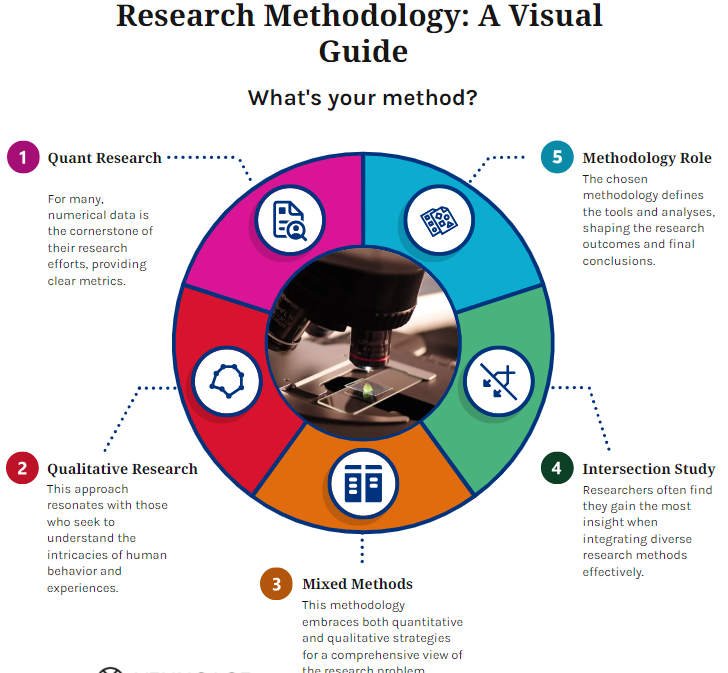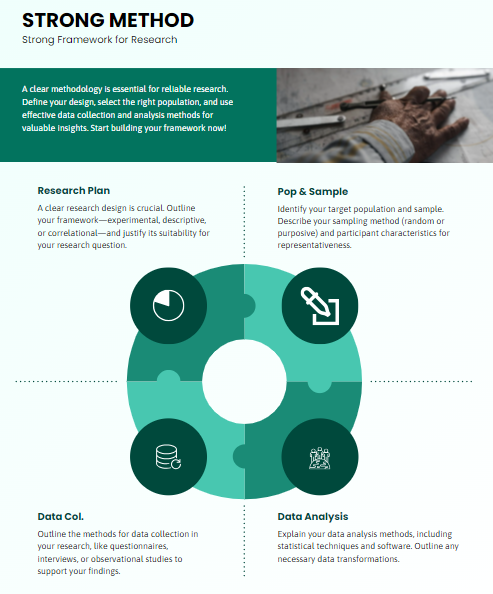The research paper methodology section, often considered the backbone of any scholarly work, is where you meticulously describe the process you used to gather and analyze data. This section serves as a roadmap for readers, allowing them to understand how your findings were derived and assess the reliability of your conclusions. A well-written methodology section not only establishes credibility but also guides future researchers seeking to replicate or build upon your work.
This comprehensive guide aims to equip you with the necessary knowledge and tools to confidently navigate the intricacies of crafting a compelling and informative research paper methodology section.
The Essentials of a Robust Research Paper Methodology Section
I. Defining the Scope: What to Include in Your Research Paper Methodology
The research paper methodology section should provide a detailed account of the steps taken during your research, focusing on the following key aspects:
- Research Design: Clearly articulate the overall structure of your research, outlining the chosen approach (e.g., experimental, descriptive, correlational) and its suitability for addressing your research question.
- Population and Sample: Describe the target population and the specific sample selected for your study, outlining the sampling method used and the characteristics of the participants.
- Data Collection Methods: Provide a detailed explanation of the methods used to collect data, including specific instruments, techniques, and procedures. This might involve questionnaires, interviews, observations, experiments, or accessing existing datasets.
- Data Analysis Procedures: Explain the methods used to analyze the collected data, specifying the statistical techniques employed, software packages used, and any specific data transformation processes.
II. The Pillars of a Strong Research Paper Methodology
While the specific content of your research paper methodology will vary based on your research topic and design, several fundamental principles ensure a strong and effective methodology section:
- Clarity and Conciseness: Use clear and concise language, avoiding technical jargon where possible. The goal is to make your methodology accessible and understandable to a broad audience.
- Logical Flow and Structure: Present the information in a logical sequence, starting with a brief overview of your research design and progressively detailing the specific methods used for data collection and analysis.
- Transparency and Reproducibility: Provide enough information to allow other researchers to replicate your study, emphasizing the specific steps taken, instruments used, and any potential limitations or biases.
- Ethical Considerations: If applicable, address any ethical considerations related to your research, outlining the measures taken to ensure participant privacy, informed consent, and responsible data handling.
III. Demystifying Common Research Paper Methodology Types
The choice of research design significantly influences the structure and content of your research paper methodology section. Let's explore three common methodology types:
- Quantitative Research: Emphasizes numerical data, often collected through surveys, experiments, or existing datasets. The methodology section will focus on the specific instruments used, sampling methods, statistical tests employed, and any data transformation processes.
- Qualitative Research: Focuses on exploring complex social phenomena through interviews, focus groups, observations, or textual analysis. The methodology section will detail the chosen qualitative approach (e.g., grounded theory, phenomenology), sampling techniques, data collection procedures, and methods for data analysis (e.g., thematic analysis, discourse analysis).
- Mixed Methods Research: Combines both quantitative and qualitative approaches, offering a more holistic understanding of the research phenomenon. The methodology section will describe the rationale for integrating both approaches, the specific methods used for each aspect, and how the results will be combined and interpreted.

Writing a Research Paper Methodology: Step-by-Step Guide
1. Start with a Clear Introduction: Begin by briefly outlining your research design and its suitability for addressing your research question. Provide a succinct overview of the research process, setting the stage for the detailed information that follows.
2. Detail Data Collection Methods: Describe the specific methods used to collect data, including instruments, techniques, and procedures. Explain the rationale behind choosing each method and its appropriateness for your research question.
- Questionnaires: If using questionnaires, provide a detailed description of the instrument, including the number of items, response scales, and any specific instructions given to participants.
- Interviews: If conducting interviews, outline the interview structure (e.g., semi-structured, unstructured), the topics covered, the duration of each interview, and any specific probing questions used.
- Observations: If using observational methods, describe the setting, the role of the observer, the duration of observations, and any specific coding schemes used to record and analyze observations.
3. Elaborate on Data Analysis Procedures: Explain the methods used to analyze the collected data, specifying the statistical techniques employed, software packages used, and any specific data transformation processes.
- Quantitative Data Analysis: Clearly state the statistical tests employed, including descriptive statistics (e.g., mean, standard deviation) and inferential statistics (e.g., t-tests, ANOVA, regression analysis).
- Qualitative Data Analysis: Describe the qualitative data analysis method employed (e.g., thematic analysis, discourse analysis, grounded theory) and provide details about the specific coding procedures, categories identified, and interpretation of the findings.
4. Address Potential Limitations and Ethical Considerations: Acknowledge any potential limitations of your research design, data collection methods, or data analysis procedures. Discuss how these limitations might affect the generalizability and validity of your findings. If applicable, address any ethical considerations related to your research, outlining the measures taken to ensure participant privacy, informed consent, and responsible data handling.
5. Ensure Clarity and Conciseness: Use clear and concise language, avoiding technical jargon where possible. Aim to make your methodology section accessible and understandable to a broad audience.
6. Review and Refine: After writing your methodology section, take the time to review and refine it thoroughly. Ensure that all information is accurate, complete, and presented in a logical sequence.

Examples of Research Paper Methodology Sections
To further solidify your understanding of crafting a research paper methodology section, let's examine two illustrative examples:
Example 1: Quantitative Research Methodology
Research Question: What is the relationship between social media usage and levels of anxiety among young adults?
Methodology:
This quantitative research employed a correlational design to examine the relationship between social media usage and levels of anxiety among young adults. A sample of 200 participants aged 18-25 was recruited using a convenience sampling method. Participants completed an online survey that included a standardized measure of social media usage (Social Media Use Scale) and a validated anxiety scale (Generalized Anxiety Disorder Scale). The data was analyzed using Pearson's correlation coefficient to determine the strength and direction of the relationship between social media usage and anxiety scores.
Example 2: Qualitative Research Methodology
Research Question: How do women in rural communities experience the impact of climate change on their lives?
Methodology:
This qualitative study utilized a phenomenological approach to explore the lived experiences of women in rural communities impacted by climate change. A purposive sample of 15 women aged 30-60 was recruited from three rural villages in a specific region. Semi-structured interviews were conducted with each participant, focusing on their experiences of climate change impacts, coping mechanisms, and perceived challenges. The interview data was transcribed verbatim and analyzed using thematic analysis to identify recurring themes and patterns in the narratives.
VI. Ensuring Quality and Credibility in Your Research Paper Methodology
A well-written research paper methodology section is crucial for establishing the credibility and reliability of your research. By following the guidelines outlined in this guide, you can ensure that your methodology section:
- Clearly communicates the research design and rationale.
- Provides detailed descriptions of data collection methods and analysis procedures.
- Demonstrates transparency and reproducibility of the research process.
- Addresses potential limitations and ethical considerations.
- Maintains clarity, conciseness, and a logical flow.
Avoiding Pitfalls in Research Paper Methodology
The research paper methodology is the backbone of your study. It outlines the systematic process you employ to collect and analyze data. However, like any intricate structure, it can be vulnerable to pitfalls that undermine the rigor and validity of your findings. Recognizing these pitfalls and implementing preventative measures are crucial for producing a robust and impactful research paper.
1. Lack of Clarity and Specificity: A poorly defined research paper methodology leaves readers unsure of the rationale behind your chosen approach. Avoid vague statements and ensure your methods are clearly articulated, explaining each step in detail. Be specific about your sampling techniques, data collection tools, and analysis procedures.
2. Inadequate Literature Review: The foundation of a strong research paper methodology lies in a thorough understanding of existing research. Failing to conduct a comprehensive literature review can lead to overlooking relevant methods or replicating previously explored areas. Ensure you cite relevant studies, identify gaps in existing research, and justify your methodological choices.
3. Ignoring Ethical Considerations: Research ethics are paramount. The research paper methodology should explicitly address ethical guidelines, data privacy, informed consent, and potential biases. Failure to adhere to these standards can lead to serious consequences for your study and its credibility.
4. Unsuitable Research Design: Choosing the wrong research design for your research question can render your findings unreliable. Carefully consider the nature of your study and select a design that aligns with your objectives. For instance, a qualitative study might require a different approach than a quantitative one.
5. Unreliable Data Collection: The research paper methodology should prioritize accurate and reliable data collection methods. Inaccurate measurements, biased sampling, or flawed instruments can introduce errors that skew your results. Implement quality control measures, utilize validated tools, and ensure proper training for data collectors.
6. Inadequate Data Analysis: Data analysis is not just about crunching numbers; it involves making sense of the collected information. A weak research paper methodology might employ inappropriate statistical tests or fail to address potential outliers. Choose statistically sound methods, justify your analysis techniques, and provide clear interpretations of the results.
7. Overlooking Limitations: Every research project has limitations. A strong research paper methodology acknowledges these limitations and discusses their potential impact on the findings. Transparency about limitations ensures readers understand the context of your study and its potential biases.
8. Lack of Reproducibility: A crucial aspect of research is reproducibility. The research paper methodology should provide sufficient detail for other researchers to replicate your study. This includes clearly outlining all procedures, data sources, and analysis techniques.
By carefully addressing these potential pitfalls, you can strengthen the foundation of your research paper methodology. Remember, a robust methodology is not just about following procedures but also about demonstrating a deep understanding of the research process and its ethical considerations. Through careful planning, attention to detail, and transparency, you can navigate the labyrinth of research and contribute to a body of knowledge that is both reliable and impactful.
Taking the time to write the research paper methodology section will lay a strong foundation for a compelling and impactful research paper. Remember, this section serves as a testament to the rigor and validity of your research, ultimately enhancing its credibility and impact within the broader scholarly community.
Get Professional Research Paper Writing Help
At Exemplary Dissertations, we offer professional assistance with research papers for a wide range of disciplines and specialties. Our service covers topic suggestion, paper writing, proofreading, editing, formatting and plagiarism removal. Besides research papers, we can also help you to write authentic essays, case studies and dissertations.